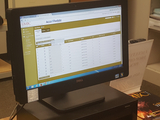How Student Disability Services Ditched Their Paper System
With help from DoIT, a new cloud solution was implemented
Student Disability Services (SDS) had a major problem. Their paper system they relied on for years was not keeping up with the increased demand they saw at their office. Rather than look for help outside, they came to DoIT with a solution in mind: implement a cloud-based system that would not only keep their department organized, but infuse it with new data analytics to gain better insights into their operations.
Tawny McManus, Director for SDS and Cassie Kilroy Thompson, Advising & Accessibility Specialist for SDS, needed accurate information not just for themselves, but for faculty as well. There would be some cases where faculty would get a letter from SDS informing them there was a student in their class who needed special accommodations, but there wouldn't be enough information about that student.
The problem with doing everything on a paper system comes from the inherent flaws of such a system. A paper system assumes everyone can come in and fill out the necessary forms. For SDS, printing out paper copies and creating files would just lead to more steps for something to get misfiled or misplaced entirely.
“You’re making people write on a card when their schedule is in a computer…”
“Students did not know their campus ID when coming in,” said McManus, “They would give us a hotmail or Gmail address, there would be no connection to other offices, and some of the handwriting was tough to read.”
“All of those bits and pieces inspired us to have something better.” said Thompson. “You’re making people write on a card when their schedule is in a computer. This is insane.”
The other problem they faced was the lack of integration with existing campus systems. Without PeopleSoft, they could not view a student's current status, or even when a student dropped or added a class.
“A lot of the information we were collecting was already in PeopleSoft.” said Thompson.
Screenshot of the Advising Appointment screen in the new Accommodate tool. Individuals gain more flexibility in choosing when they want to meet and for long they are able to.
One of the many services SDS employs is student note takers. Before, their process required note takers to come into the office just to wait in line to get to a form they had to fill out. SDS would then received an overwhelming amount of requests that required a face to face interaction.
This is where Bryan Lee, a Cloud Business Analyst for DoIT, came in. Working together with McManus and Thompson in addition to the vendor Symplicity, they were able to create a cloud-based solution, called Accommodate, that met the business needs of SDS.
SDS now had access to PeopleSoft data in Accommodate so they could see when students dropped or added classes and even their schedule. They could also pull relevant and up to date contact information straight from PeopleSoft as well.
“The data is literally there in a minute....”
In addition, SDS was able to track all their tickets and have them update for everyone at the same time. They could view notes written on each ticket and see who was signed up for note taking and for which classes, at a glance. “No more lines to sign up for being a note taker” said McManus. Also, thanks to integration of Single Sign On (SSO), both the department and students could log in just by using their myUMBC credentials, increasing security for the student and allowing for overall better data analytics reporting.
SDS was also technically no longer restricted to the office for business information. McManus said, “The data is literally there in a minute, I can log in from my phone [or] at home and quickly see what tickets were made, if they are active, classes, status, or major.” Thompson shared a similar experience, where she was able to open up everything on her ipad to find out a student’s schedule.
“Part of our mission is to empower students to be more independent.”
An added benefit to migrating to the new Symplicity tool was just how much independence it gave to students. Students could now schedule appointments themselves, which feeds into part of SDS’s mission. “[This] allowed students more freedom to do everything themselves.” said Thompson, “Part of our mission is to empower students to be more independent.”
“Having other modules from Symplicity, it’s nice to know who's going to walk into your office before they get there.” said Thompson.
Working with DoIT was a key highlight for McManus and Thompson. “Bryan would ask what we do, and tried to understand what we were doing and helped shape the needs of our department. We didn't expect ongoing communication, we thought IT would stop after it is implemented.” said McManus.
By collaborating with DoIT, SDS was able to find a solution that met the business needs of their department. “When people ask me for data, I feel 100% confident to give it to them now.” said McManus.
You can follow the myUMBC Group for SDS here
Tags:
Posted: January 17, 2017, 11:52 AM
